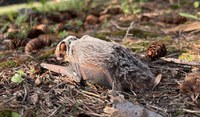Dakota Gardener: Creatures of the night
(Click an image below to view a high-resolution image that can be downloaded)
By Carrie Knutson, Horticulture agent
NDSU Extension – Grand Forks County
I don’t usually get the typical creepy-crawly feeling when it comes to wildlife, excluding snakes and very large spiders. However, a few weeks ago, I stumbled across a creature I had not encountered in person. This small, furry creature was close to making me turn tail and run away…it was a bat.
According to the North Dakota Game and Fish Department, there are seven bat species present in North Dakota. Of the seven species, only two—the Big Brown and Western Small-footed bat—are reported as living year-round in North Dakota. The Long-eared and Long-legged bat are possible year-round residents. The Little Brown bat, Northern Long-eared and Townsend’s Big-eared bats are seasonal.
While the bats all have different names and features, they do have some things in common. The bats that overwinter in North Dakota do so in what is called “hibernacula.” Hibernacula are caves, mines or rock crevices that do not experience freezing temperatures. High humidity is also needed in the hibernacula.
Bats are most commonly found in wooded or rugged terrain areas. Common areas to find them in North Dakota include the Badlands and wooded habitats in the Turtle Mountains, as well as along the Little Missouri and Missouri Rivers. Bats will make homes in rock crevices, under leaves and underneath tree bark. They can also make themselves at home in your buildings.
Bats are most active at night when they hunt their prey. Contrary to the bats mentioned this time of year, bats that call North Dakota home prefer to eat insects. In fact, according to the University of Missouri Extension, bats can eat about 600 mosquitoes an hour. Just like any other animal, they have a role in our ecosystems. Bats in other ecosystems serve as important pollinators and disperse seeds.
Bats are mammals that give birth to one or two young a year. They do have good eyesight, but they rely on their hearing and echolocation to hunt and fly at night. Bats are generally not aggressive. However, it is important to note that bats can carry disease. Don’t handle bats or keep one as a pet. If you must handle a bat, wear leather gloves.
The presence of bats in our state can be a common or uncommon sight, depending on where you are located. However, their numbers are decreasing due to low reproductive rates, habitat disturbances, especially in their rearing areas and the use of pesticides.
It doesn’t help that the general public has a negative perception of bats. I wonder how many readers actually finished reading this article, or if the creepy-crawly feeling was even too much just from the picture? Happy gardening!
NDSU Agriculture Communication – Oct. 15, 2025
Source: Carrie Knutson, 701-780-8229, carrie.knutson@ndsu.edu
Editor: Kelli Anderson, 701-231-6136, kelli.c.anderson@ndsu.edu




